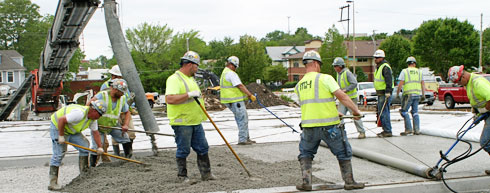KCATA Constructs Kansas City’s First Pervious Concrete Parking Lot
Posted on: May 20, 2010

(Kansas City, Mo. -- May 19, 2010) The Kansas City Area Transportation Authority (KCATA) is building the first pervious concrete parking lot in Kansas City, Mo., as part of the new MAX on Troost bus rapid transit (BRT) line. The park-and-ride lot at 31st & Troost will also include new landscaping, lighting, passenger seating, and public art.
Pervious concrete reduces the runoff of polluted water. Rainwater soaks through the pervious concrete, replenishing natural aquifers and protecting streams. Storm water runoff from parking lots includes oils and other hydrocarbon liquids that can be filtered through the pervious concrete.
"KCATA is incorporating several green technologies such as rain gardens, electric hybrid vehicles, and solar lighting, on the new MAX on Troost BRT line," said Dick Jarrold, Senior Director of Engineering and System Development. "The pervious concrete park-and-ride lot is one of these green solutions that will benefit both the air quality and the water quality while providing a convenient midtown park-and-ride.”
BRT Project Administrator Keith Sanders said, “After the community gets a chance to see how the pervious concrete performs at the 31st & Troost Park-and-Ride lot, we expect to see greater use of this green paving material around the city."
Pervious concrete allows up to eight gallons per square foot per minute to drain through. According to the National Ready Mixed Concrete Association, pervious concrete also improves air quality by lessening the heat island effect of parking lots. The lighter color of the concrete and lower density lets the concrete capture less heat than a conventional concrete or asphalt parking lot.
The pervious concrete was placed at the 31st & Troost Park-and-Ride lot last week and will be shown to the public at Troost Festival on Saturday, May 22.
About MAX
KCATA implemented its first BRT line on Main Street in July 2005. The success of MAX on Main paved the way for a second BRT line that will open on Troost Avenue in 2011. MAX on Troost will not only provide an exciting transit upgrade for The Metro’s highest ridership route, but will also contribute to revitalizing the Troost corridor. This investment is intended to improve service and amenities for existing riders, but also to attract new riders.


